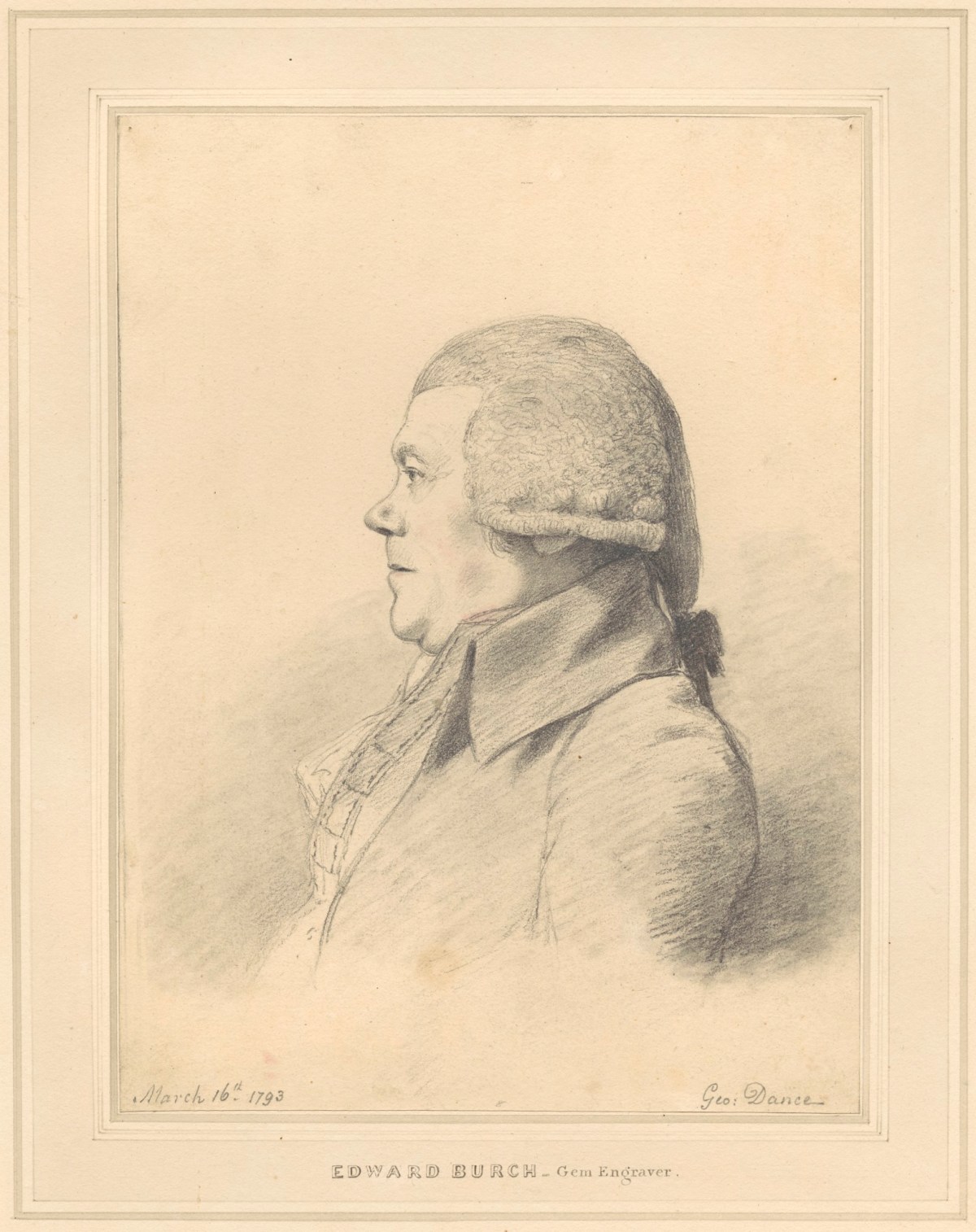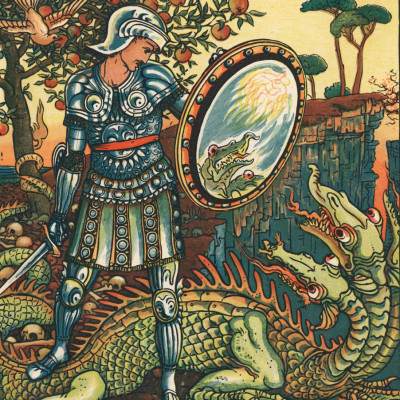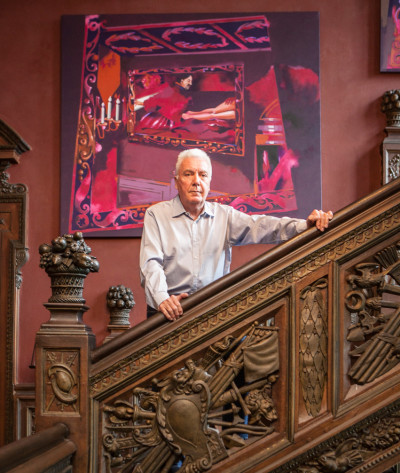What Was the Title of Burchs Final Work of Art

Portrait of Edward Burch, R.A., 16 March 1793
George Trip the light fantastic toe RA (1741 - 1825)
RA Collection: Art
A profile portrait of the gem engraver Edward Burch R.A., (1730-1814). Like most of Dance'south 'heads', this portrait is fatigued in pencil and black chalk with the faintest hint of pink effectually the cheeks, jowls and lips.
Burch taught himself gem-engraving but studied drawing at the St. Martin'southward Lane Academy and at the Royal University Schools. He was director of the Society of Arts and was elected A.R.A. in 1770 and a full Academician in the following year. Although successful in the 1770s, failing sight and a decline in demand for his engraved gems left him in penury by the end of the century. Probably to assist Burch'due south fiscal predicament, the Academy appointed him Librarian in 1794.
The proper noun of the sitter on the mount was probably written by the artist or Joseph Farington (see group record) and it is very unusual that they included Burch's profession, 'Gem Engraver', in the inscription. It may indicate that Burch was not well-known past the fourth dimension Dance was preparing to publish his set of portraits of Academicians.
Between 1793 and 1810, George Dance produced 53 profile portraits of his fellow Academicians. Dance, an builder past profession, made it his hobby to draw portraits of friends and well-known figures, providing what he chosen 'a great relaxation from the severer studies and more laborious employment of my professional life'.
Withal, the project to record the profiles of his swain Academicians probably had a more serious commemorative impetus as Dance began this project in 1793 - the silver jubilee of the Royal Academy's foundation - and the majority of the portraits engagement from that yr. Those drawn later announced to have been part of a less concentrated attempt to record new members or to grab up on those who had been missed out in the initial series. Only two Academicians who were resident in Britain at the time were non drawn by Dance - Mary Moser and P. J. de Loutherbourg. Almost all of the drawings evidence the sitters in profile though in that location are some slight variations such equally the portrait of Richard Cosway (03/3260) who is seated in a frontal pose with his head turned to the side (see besides Thomson 04/1249, Opie 03/2666, Richard Westall 03/2657, Smirke 03/2655 and Nollekens 03/2650).
Although it was announced in The Oracle in 1793 (24th April 1793) that 'Mr George Dance the Architect has been drawing the contour portraits of the Academicians', the minutes of the General Assembly and the University's Council practice not record any resolutions regarding these activities. Trip the light fantastic toe's private project could yet take been officially supported or recognised by the institution. The compatible nature of these profile portraits had the advantage of being very democratic and, dissimilar other commemorative initiatives, giving each fellow member equal merit.
Joseph Farington, a fellow RA, took a particular involvement in Dance's project. His assistance in organising sittings for Dance and helping to arrange the drawings into 'volumes', is recorded in his famous diaries. This activity seems to accept been closely linked to his own efforts to compile biographical information on living and dead artists, presumably with a view to publishing a history of the Academicians.
In July 1797, Farington's diaries record that he and Dance had been arranging the portraits into two volumes and were in discussion virtually how they should be jump. Markings on the original mounts suggest that the drawings were indeed bound although these bindings no longer survive. This is confirmed by J. H. Anderdon'southward recollection that he viewed some of Dance'south heads in a leap volume in the RA Library in 1849 and 1864. Dance and Farington may have been trying to involvement the Academy, or at least other Academicians, in their venture equally Farington records that on January 29th 1799 that 'Fuseli and Mrs Fuseli, Opie and Mrs Opie drank tea with u.s. - to meet the University portraits past Dance' (Farington p. 1149). Although this activeness did not result in a biographical publication, the idea evidently remained current for some fourth dimension every bit, seven years later on December 31st 1806, Farington recorded that 'Dance called to want me to have his drove of Portraits & to help. with Biography. - Had doubts abt. World'due south [probably referring the publication of that name] remarks abt. information technology being out of his line - but now at fourth dimension of life to pay little regard to such remarks to avoid [illegible] & to seek for ease & amusement etc'.
Although Farington's biographical work was never published, he and Trip the light fantastic were considering having the profile portraits engraved from as early every bit 1794. Farington'south diary shows that on ninth August of that year Dance was already in discussion with an engraver on this matter. The engraver'southward name is not specified but in November the same year John Ogbourne had engraved Trip the light fantastic's profile of Lord Camden and was most to start piece of work on that of Sir William Chambers. Nonetheless, 72 of Trip the light fantastic toe's portaits were etched by William Daniell , including 16 of the Academicians' portraits, and were published along with brief biographical notes from 1802 onwards in 12 monthly parts and a further set of 142 unbound prints was published in 1851. The reaction to the original publication of Dance's profiles seems to take been positive but Farington recorded that 'Dance told me Landseer had in a Quarterly Critique been criticising His publication of Heads, & "That the eyes were too small, non similar annihilation in nature in the proportions & that there was a want of Skull to the Heads" ' (tenth May 1809) .
Related Objects:
At that place are 38 portrait drawings by Trip the light fantastic in the National Portrait Gallery collection, 41 in the British Museum, a small number at the V&A, Tate Uk and the John Soane Museum.
All objects in this group
Object details
Championship
Portrait of Edward Burch, R.A.
Medium
Pencil with blackness and pink chalks on cream wove paper
Dimensions
250 mm 10 186 mm
Drove
Royal Academy of Arts
read more
- Explore art works, pigment-smeared palettes, scribbled messages and more...
- Artists and architects have run the RA for 250 years.
Our Collection is a tape of them.
Start exploring




0 Response to "What Was the Title of Burchs Final Work of Art"
ارسال یک نظر